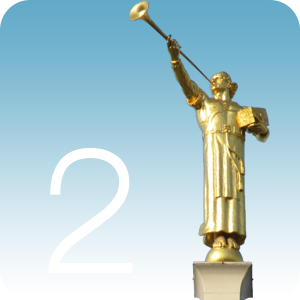
| COMMISSIONED | 1951 |
| HEIGHT | 15’ 5.5” (4.7 Meters) |
| MATERIAL | Welded Aluminum |
| WEIGHT | 2,101 lbs. (953 kilograms) |
| CURRENTLY ON | 1 Temple |
Angel in the City of Angels
The tradition of a statue on every temple did not begin with Cyrus Dallin. His iconic Angel Moroni statue for the Salt Lake Temple has become a symbol for the church. But five temples would be constructed without statues. Another sixty-two and a half years would pass before another Angel Moroni Statue would be placed on a temple. Dallin’s creation would influence all to come. All the statues to follow keep the horn and the upright position of Dallin’s Statue. But the next statue would be as distinct in design from the Salt Lake Statue as that statue was from the Nauvoo weather vane.
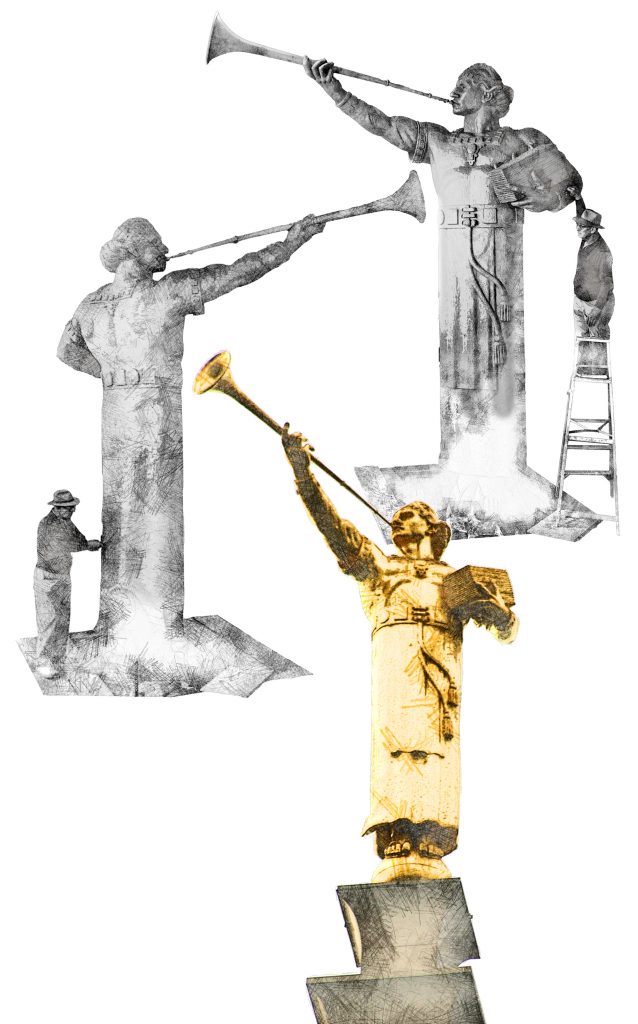
The New Temple
Thirteen acres of property had been purchased from the estate of movie celebrity Harold Lloyd in 1937. Announcement of a temple followed soon after. By this time, three more temples had been completed in the world, one each in Laie Hawaii, Cardston Alberta, and Mesa Arizona. Each of these temples had been built without an Angel Statue. Although initial concepts for the Mesa Temple featured a statue, the design ultimately selected did not have one.
There were now seven temples in the world. Only one of those seven had an Angel Statue. Even the recently begun Idaho Falls Temple had would have no Angel atop its forth coming spire. It would appear the intention was that the flagship temple in Salt Lake would remain a unique structure, with the Angel Moroni Statue being a part of its uniqueness.
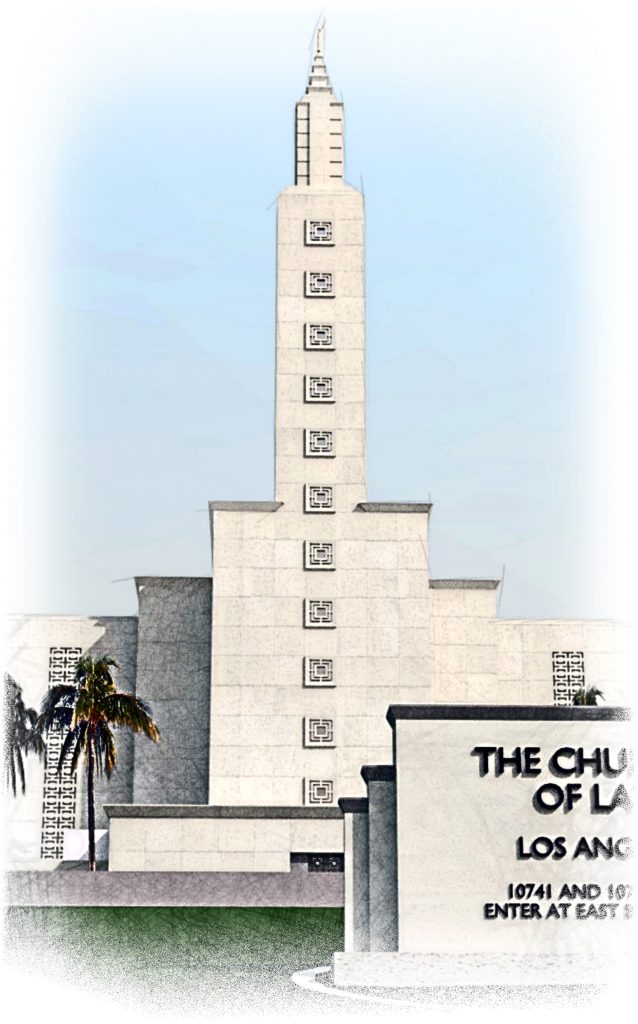
However, an early plan for this new temple in Los Angeles exists, drawn by Edward O. Anderson. It showed a contemporary design, with a single spire and an Angel statue at the top.[1]Anderson, Edward Oliver 1891-1977. Los Angeles Temple rendering, circa 1940, (accessed: August 12, 2019) For the first time in 45 years a statue was being seriously considered for a temple. Unfortunately, the outbreak of World War II put all plans on hold for Los Angeles, and even added a delay to Idaho Falls.
Construction moved forward again under the direction of David O. McKay, now President of the Church. President McKay, like many of the Presidents who would follow after him, recognized the symbol that the Angel Statue was becoming for the Church. Such a symbol could be of value in promoting the Church and bringing people to the Gospel. President McKay desired that this new California Temple have an angel statue as well. As construction commenced on the Los Angeles California Temple in 1951, Millard Malin was commissioned to design a new statue. Malin had been a fellow student of Professor Edwin Evans at the University of Utah with Church Architect Edward O. Anderson.[2]Malin, Millard Fillmore 1891-1975. Millard F. Malin autobiographical sketch, circa 1966, (accessed: August 8, 2019) When the need arose for someone to Design the statue, Brother Anderson turned to his old friend, now a well-recognized sculptor. The Two friends had already collaborated together on the Sugarhouse Monument in the Salt Lake Area.[3]Malin, Millard F, “Millard F. Malin Papers 1923-1968 (Inclusive,) Special Collections, J. Willard Marriott Library, Salt Lake City, Utah Malin was contracted to also create the Oxen and Font for the Los Angeles Temple.
Malin’s Style
Designed solely for the Los Angeles California Temple, Malin’s Moroni is one of a kind. According to the sculptor, the style was significantly influenced by the paintings his friend of Arnold Friberg.[4]Smith, Henry A., “Another Monument to Moroni,” Church News, 16 January 1954, p.6 The larger than life style of Friberg’s Book of Mormon Paintings can be seen in the muscle tone of the statue. Friberg also suggested the placement of the trumpet, which fits into the lips gracefully, and is held out from the body by a fully extended arm. Dallin’s statue had used a military style stance, the bent elbow forcing the trumpet against crushed lips.[5]Malin, Millard Fillmore 1891-1975. Millard F. Malin autobiographical sketch, circa 1966, (accessed: August 8, 2019)
The statue and was described by Malin as being “Indian in type … and wears a costume which might be made of leather.”[6]Malin, Millard Fillmore 1891-1975. Millard F. Malin autobiographical sketch, circa 1966, (accessed: August 8, 2019) The sleeves, collar and belt around the waist are square outlined in square designs and shaped to be heavily outlined and noticeable from a distance. Aside from the unique style in the clothing this, 15 foot tall statue boasts two other features not used on any other Moroni Temple Statue to date.
First, the manner that the right hand holds the trumpet with the palm upturned and the trumpet resting in the loose hand. Again, this is part of the pose suggested by Friberg. All other versions of the statue currently in use have the left hand palm down with a firm grip on the trumpet.
Second, unlike all the other versions of the statue currently in use on temples which feature bare feet, this statue wears sandals. This statue stands upon a sphere that is 33 inches in diameter.[7]Sears, Jack, “A Sacred Witness To all Men,” The Instructor, March 1956
Another feature of this statue would also be implemented in a more recent version of the Angel Moroni. It is the first of two statue versions created where the statue is holding Gold Plates in the crook of his left arm.
Sculpting
Malin sculpted first a 40-46 inch maquette to plan out the design for the angel. Having studied human anatomy at the University of Utah, Malin sculpted the statue without any human being to model for him.[8]Smith, Henry A., “Another Monument to Moroni,” Church News, 16 January 1954, p.6
Construction of the full-scale statue was completed at a temporary studio at the Otto Buhner Concrete Co. plant in south Salt Lake City,[9]Malin, Millard Fillmore 1891-1975. Millard F. Malin autobiographical sketch, circa 1966, (accessed: August 8, 2019) just north of 4500 south. Buehner Co. was then making the Mo-soi cast stone panels for the Los Angeles Temple. It had hitherto made the cast stone panels for the exterior of the Idaho Falls Temple, the first-time precast concrete or stone panels had ever been used on a temple. This studio would additionally be utilized to create the font and oxen for the Los Angeles, Bern Switzerland, London England, and Hamilton New Zealand Temples.
Two major design features were incorporated into this studio to assist Malin with the job. First, to provide ample light, the North side of the studio was comprised completely of windows. These windows could be thrown wide open, allowing Malin to take in the sculpture from a distance to identify issues that you might miss when viewing it up close.
The second feature was the construction of a pit, four feet deep, below floor level that was lined with concrete. This pit housed a turntable, as well as the ball the angel stood upon. The pit dropped the statue low enough it could still be lit from above. Despite the weight of the statue, the turntable within the pit allowed a couple of Buhner’s crew to use crowbars to rotate the statue when necessary.
After perfecting his small maquette, Malin sculpted the full size statue, 15 ½ feet from head to heel. This was achieved by constructing a framework or armature, known as a “mandrill,” as a center support for the statue. 2 tons of plastelene clay is then applied to the mandrill to fill out the statue’s rough dimensions.[10]Sears, Jack, “A Sacred Witness To all Men,” The Instructor, March 1956 Careful measurements of the original maquette were taken, scaled up, and applied to the full-size statue.[11]Malin, Millard Fillmore 1891-1975. Millard F. Malin autobiographical sketch, circa 1966, (accessed: August 8, 2019) He was assisted in this work by Maurice Brooks, Torlief Knaphus and Elbert Porter.[12]Smith, Henry A., “Another Monument to Moroni,” Church News, 16 January 1954, p.6
Casting
One thousand pounds of plaster of Paris was then used to create a 5 piece mold of this full size statue. [13]Smith, Henry A., “Another Monument to Moroni,” Church News, 16 January 1954, p.6 The molds were then shipped to Roman Bronze Works in New York along with the plaster cast molds for Malin’s sculptures for the font and oxen. There, the font and oxen were cast in bronze and the statue was cast in Aluminum.
The casting was performed by coating the negative image of the statue on each plaster cast segment with molten aluminum. This creates a positive metal image of the casting contained on that section of plaster. These five aluminum segments next had their edges cleaned up and were fitted and welded to each other like a puzzle. [14]Smith, Henry A., “Another Monument to Moroni,” Church News, 16 January 1954, p.6 The finished statue ranges in thickness from 3/8 of an inch to several inches.[15]Lundstrom, Joseph “Angel Moroni Statue Lifted to Top of L. A. Temple Steeple,” Church News, 23 October 1954.
Straightening the Statue
In his autobiography Millard Malin recounts an anecdote about the casting of the statue. During the casting process he flew out to New York to check on the assembly process. Upon his arrival, he found that the metalworkers had decided that the statue would look more magnificent leaning forwards a little bit. They had, of course, not consulted Malin or the Church on this change. Besides the concern about any stress the off-centering of the weight may have caused, there was the issue of design. The whole statue had been precisely sculpted with straight vertical lines to compliment the design of the temple spire. This impromptu plan was unacceptable to Malin. Fortunately, Malin arrived early enough that he was able to get them to repair their artistic tilt prior to the completion of the entire statue.[16]Malin, Millard Fillmore 1891-1975. Millard F. Malin autobiographical sketch, circa 1966, (accessed: August 8, 2019)
Elder Cowley’s Signature
Malin recounted another story from the sculpting in an interview he gave during the Los Angeles Temple open house. He told the story of how his good friend Elder Mathew Cowley visited him to see the completed clay statue before it was sent off to be cast in aluminum. Elder Cowley said “It is superb!- I like it-like everything about it.” Malin subsequently invited his friend to sign the Statue. Malin was exceptionally careful to protect the initials “MC” carved on the bottom edge of the back of the robes through every step of finishing and placing the statue.[17]Sears, Jack, “A Sacred Witness To all Men,” The Instructor, March 1956
Like its predecessor, this statue is also designed to function as a lightning rod. The Los Angeles Temple was, and still is, one of the tallest buildings in the near vicinity. In the case of this statue, there is a lightning rod with grounding wire embedded in the right hand, holding up the trumpet.[18]Swift, Melba B., “Moroni Gets a New Gold Overcoat on L.A. Temple,” Church News, 27 March 1982.
The casting of the figure took three months. Once completed, the statue was loaded on a truck, and shipped off to Los Angeles.[19]Church News, 15 March 1958.
Gilding
The statue traveled by truck, from east coast to west coast, on an 8 day transcontinental trip. It arrived at the temple the morning of the 9th of October 1954. [20]Lundstrom, Joseph “Angel Moroni Statue Lifted to Top of L. A. Temple Steeple,” Church News, 23 October 1954. The statue was then lifted, by crane, to a spot prepared for it on the roof of the temple behind the spire. It was placed upright and surrounded by scaffolding for the process of gilding.[21]Lundstrom, Joseph “Angel Moroni Statue Lifted to Top of L. A. Temple Steeple,” Church News, 23 October 1954.[22]“Statue Arrives,” Church News, 16 October 1954, p. 1 Helmuth Rimmach working for Lippold Co. of Salt Lake City then gilded the statue. This process consisted of covering the statue with zinc oxide, then a coat of White lead paint in a process known as sizing. Once sizing was completed, the statue was covered in a fine layer of 23-caret gold leaf. The 8-foot-long trumpet,[23]Winn, Howard Christensen 1920-. Los Angeles Temple construction, 1953-1954; 1956 , (accessed: August 12, 2019) which was shipped as a separate piece, was gilded separately and added last.[24]“Church Leader Approves,” Church News, 23 October 1954. The gilding process took three days. [25]Lundstrom, Joseph “Angel Moroni Statue Lifted to Top of L. A. Temple Steeple,” Church News, 23 October 1954.
Placement
Many people gathered at the temple on 19 October 1954. President David O. McKay and his wife were on hand to watch as the statue was lifted into place atop the spire on. The process took about an hour as the Masonry Supervisor, Stanly C. Child and his crew hoisted the statue the rest of the way up the spire and into position.[26]Lundstrom, Joseph “Angel Moroni Statue Lifted to Top of L. A. Temple Steeple,” Church News, 23 October 1954.
Unlike the copper Salt Lake Statue, the Malin Statue is aluminum. The lower weight, combined with more modern construction methods, meant that the statue did not require any unusual or extraordinary balancing system. Instead, a single steel post running through the statue and out the bottom of the sphere the statue stands upon. In a photo in the Improvement Era of November 1955, page 804, this post can be seen just over President McKay’s shoulder.[27]Anderson, Edward O., “The Los Angeles Temple,” Improvement Era, (November 1955) It sticks out of the bottom of the ball by about 5 feet, and according to Malin was about 4 inches in diameter.[28]Malin, Millard Fillmore 1891-1975. Millard F. Malin autobiographical sketch, circa 1966, (accessed: August 8, 2019) This post was slid into a slightly larger tube welded to the interior framework inside the spire.
This post and socket method has been used on every statue since. In the case of the Los Angeles Temple statue, two sets of heavy duty set screws, spaced four feet apart secured the statue against further movement, and allowed for vertical truing of the statue.
[29]Malin, Millard Fillmore 1891-1975. Millard F. Malin autobiographical sketch, circa 1966, (accessed: August 8, 2019) It is a far cry from the lever and counterweight system used at the Salt Lake Temple 60 years earlier.
President McKay would request the statue be rotate 90 degrees counter clockwise after placement. The location and placement of the set screws caused the statue to develop a slight tilt. On the event, Malin later remarked that the metal workers who tried to tilt the statue initially, got a small portion of what they were going for in the end. [30]Malin, Millard Fillmore 1891-1975. Millard F. Malin autobiographical sketch, circa 1966, (accessed: August 8, 2019)
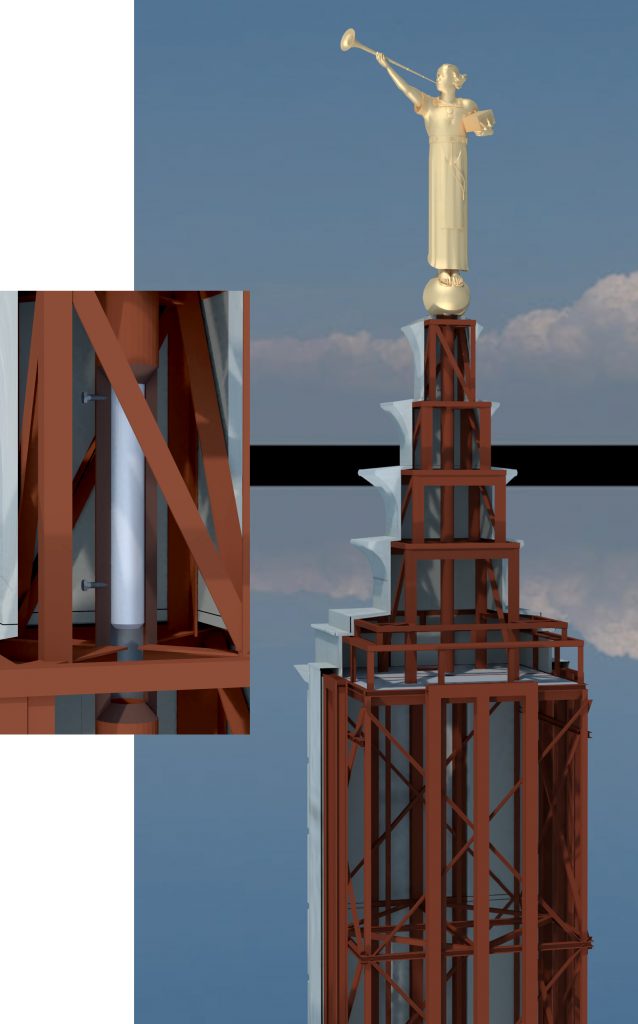
Cutaway of the spire showing the socket tube within the center of the spire framing (right)
Maintenance
The leafing on the statue was planned to last a long time. It was 28 years before the statue would receive some upkeep, in March of 1982.[31]Swift, Melba B. “Moroni gets a new gold overcoat on L.A. Temple,” Church News, 27 March 1982. Scaffolding was erected around the spire so that Henning Anderson of Salt Lake and his crew could re leaf the statue. The process consisted of first using a wire brush and sandpaper to strip as much of the original leaf and sizing off the statue. The statue was then cleaned and a modern sizing paste created for gold leafing was applied. Then new gold leaf, in squares 3 3/8 of an inch in size was placed, square by square, across the entire surface of the statue. Lastly a soft brush of Badger or Squirrel hair was used to “burnish” the leaf, or brush it as a way of polishing it to a high shine.[32]Swift, Melba B. “Moroni gets a new gold overcoat on L.A. Temple,” Church News, 27 March 1982. Maintenance of this type is necessary for all of the Gold Leafed Angel Moroni Statues.
This Aluminum statue is lighter weight than its predecessor, but the aluminum needs periodic repair due to the way the surface pits when struck by lightning.[33]Roe, Frederick Robert 1920-. Angels: Moroni and his associates / Fred Roe [Bountiful, Utah]: The Author, 1992 May 1992 printing, (accessed: August 12, 2019) Copper could have been used to produce a statue of this size, or copper as had been done at the Salt Lake Temple. However, Los Angeles building codes put a limit to the amount of weight which could be placed so high up.[34]Smith, Henry A., “Another Monument to Moroni,” Church News, 16 January 1954, p.6
The Los Angeles Temple Moroni was only the second ever temple to have an Angel Moroni Statue. It was not the start of the tradition of placing angel statues on most every temple. Nearly 19 years and 5 more temples were to come before another statue would be used on a temple.
Identification Guide
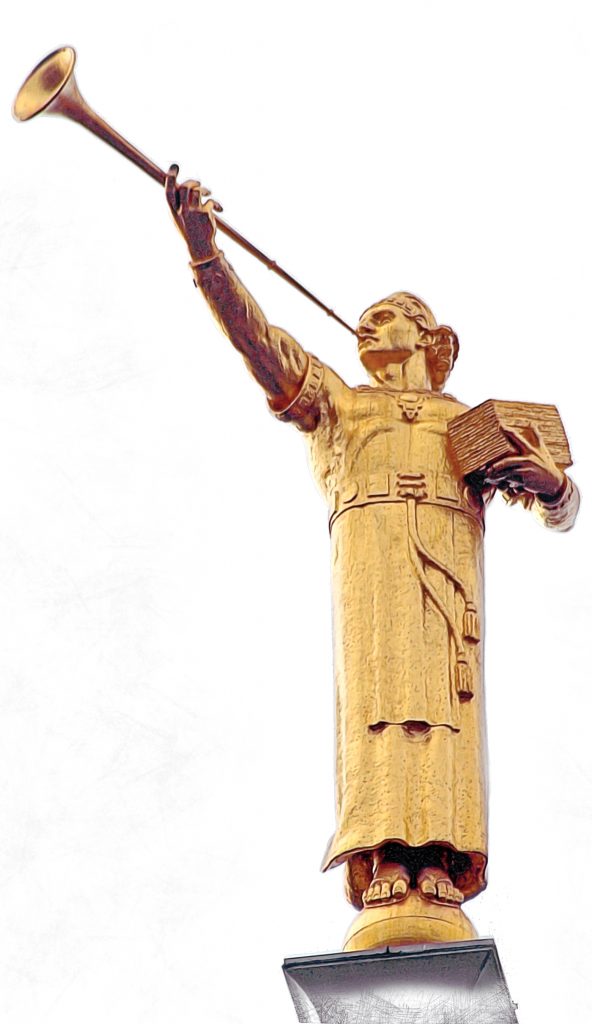
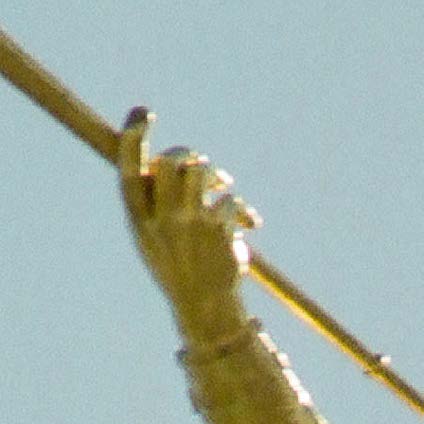
Upturned Palm
This is the only Moroni statue that holds the trumpet in an upturned right palm, rather than with the right hand wrapped around the trumpet
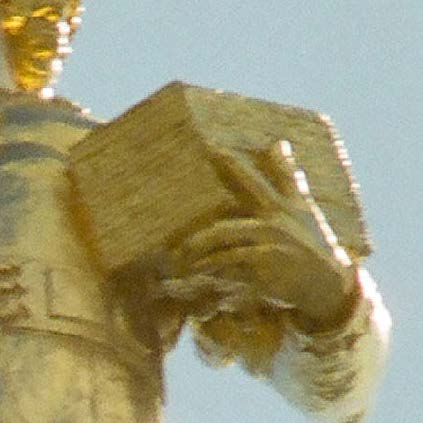
Gold Plates
This Angel Moroni holds a reproduction of the Gold plates from which the Book of Mormon was translated, nestled in the crook of his left arm.

Distinctive Garb
The robe, belt, and headband convey Mayan culture as understood from the era the statue was sculpted.
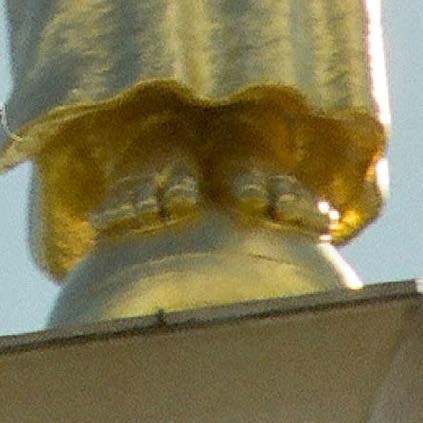
Sandals
Besides the distinctive clothing, this is currently the only Moroni on temples that is not barefoot.
Chapter 3 Navigation
Related Articles
Millard Malin →
Torlief Knaphus →
Elbert Porter →
References
| ↑1 | Anderson, Edward Oliver 1891-1977. Los Angeles Temple rendering, circa 1940, (accessed: August 12, 2019) |
|---|---|
| ↑2, ↑5, ↑6, ↑9, ↑11, ↑16, ↑28, ↑29, ↑30 | Malin, Millard Fillmore 1891-1975. Millard F. Malin autobiographical sketch, circa 1966, (accessed: August 8, 2019) |
| ↑3 | Malin, Millard F, “Millard F. Malin Papers 1923-1968 (Inclusive,) Special Collections, J. Willard Marriott Library, Salt Lake City, Utah |
| ↑4, ↑8, ↑12, ↑13, ↑14, ↑34 | Smith, Henry A., “Another Monument to Moroni,” Church News, 16 January 1954, p.6 |
| ↑7, ↑10, ↑17 | Sears, Jack, “A Sacred Witness To all Men,” The Instructor, March 1956 |
| ↑15, ↑20, ↑21, ↑25, ↑26 | Lundstrom, Joseph “Angel Moroni Statue Lifted to Top of L. A. Temple Steeple,” Church News, 23 October 1954. |
| ↑18 | Swift, Melba B., “Moroni Gets a New Gold Overcoat on L.A. Temple,” Church News, 27 March 1982. |
| ↑19 | Church News, 15 March 1958. |
| ↑22 | “Statue Arrives,” Church News, 16 October 1954, p. 1 |
| ↑23 | Winn, Howard Christensen 1920-. Los Angeles Temple construction, 1953-1954; 1956 , (accessed: August 12, 2019) |
| ↑24 | “Church Leader Approves,” Church News, 23 October 1954. |
| ↑27 | Anderson, Edward O., “The Los Angeles Temple,” Improvement Era, (November 1955) |
| ↑31, ↑32 | Swift, Melba B. “Moroni gets a new gold overcoat on L.A. Temple,” Church News, 27 March 1982. |
| ↑33 | Roe, Frederick Robert 1920-. Angels: Moroni and his associates / Fred Roe [Bountiful, Utah]: The Author, 1992 May 1992 printing, (accessed: August 12, 2019) |
